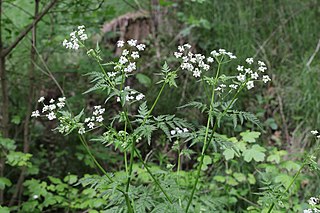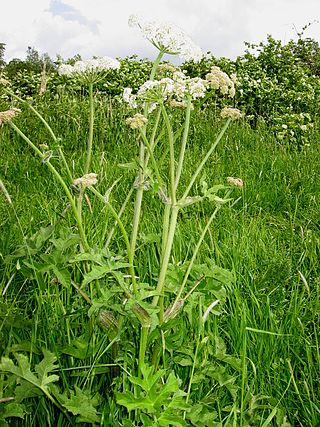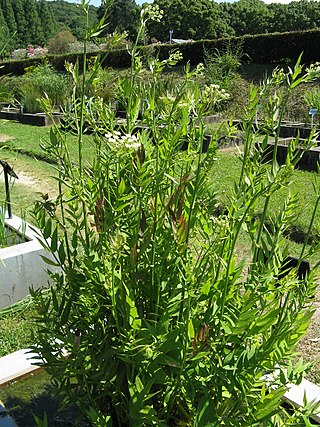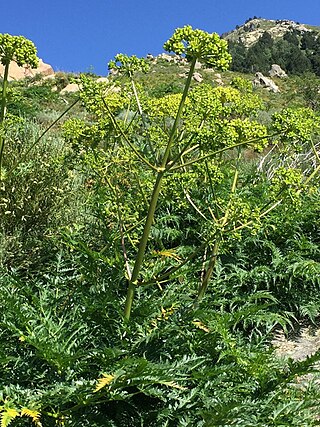
Apiaceae or Umbelliferae is a family of mostly aromatic flowering plants named after the type genus Apium and commonly known as the celery, carrot or parsley family, or simply as umbellifers. It is the 16th-largest family of flowering plants, with more than 3,800 species in about 446 genera, including such well-known and economically important plants as ajwain, angelica, anise, asafoetida, caraway, carrot, celery, chervil, coriander, cumin, dill, fennel, lovage, cow parsley, parsley, parsnip and sea holly, as well as silphium, a plant whose identity is unclear and which may be extinct.

The Araliaceae are a family of flowering plants composed of about 43 genera and around 1500 species consisting of primarily woody plants and some herbaceous plants commonly called the ginseng family. The morphology of Araliaceae varies widely, but it is predominantly distinguishable based on its woody habit, tropical distribution, and the presence of simple umbels.

Asafoetida is the dried latex exuded from the rhizome or tap root of several species of Ferula, perennial herbs of the carrot family. It is produced in Iran, Afghanistan, Central Asia, northern South Asia, and Northwest China (Xinjiang). Different regions have different botanical sources.

Conium is a genus of flowering plants in the family Apiaceae. As of December 2020, Plants of the World Online accepts six species.

Apium is a genus of about 20 species of flowering plants in the family Apiaceae, with a subcosmopolitan distribution in Europe, Asia, Africa, South America and Australia. They are medium to tall biennials or perennials growing up to 1 m high in the wet soil of marshes and salt marshes, and have pinnate to bipinnate leaves and small white flowers in compound umbels. Some species are edible, notably Apium graveolens, which includes the commercially important vegetables celery, celeriac and Chinese celery. Apium bermejoi from the island of Menorca is one of the rarest plants in Europe, with fewer than 100 individuals left.

Anthriscus sylvestris, known as cow parsley, wild chervil, wild beaked parsley, Queen Anne's lace or keck, is a herbaceous biennial or short-lived perennial plant in the family Apiaceae (Umbelliferae), genus Anthriscus. It is also sometimes called mother-die, a name that is also applied to the common hawthorn. It is native to Europe, western Asia and northwestern Africa. It is related to other diverse members of Apiaceae, such as parsley, carrot, hemlock and hogweed. It is often confused with Daucus carota, another member of the Apiaceae also known as "Queen Anne's lace" or "wild carrot".

Heracleum sphondylium, commonly known as hogweed or common hogweed, is a herbaceous perennial plant in the carrot family Apiaceae, which includes fennel, cow parsley, ground elder and giant hogweed. It is native to most of Europe, western Asia and northern Africa, but is introduced in North America and elsewhere. Other common names include cow parsnip or eltrot. The flowers provide a great deal of nectar for pollinators.
Capnophyllum is a genus of flowering plant in the Apiaceae. It contains four species. They are endemic to southern Africa, particularly near the Cape of Good Hope.

The furanocoumarins, or furocoumarins, are a class of organic chemical compounds produced by a variety of plants. Most of the plant species found to contain furanocoumarins belong to a handful of plant families. The families Apiaceae and Rutaceae include the largest numbers of plant species that contain furanocoumarins. The families Moraceae and Fabaceae include a few widely distributed plant species that contain furanocoumarins.

Conioselinum is a genus of flowering plant in the family Apiaceae, native to Eurasia and North America. Its species are erect perennial plants with deeply toothed compound leaves and umbels of white flowers. Plants of this genus are known commonly as hemlock-parsley.
Vvedenskya is a monotypic genus of flowering plants belonging to the family Apiaceae. It just contains one species, Vvedenskya pinnatifoliaKorovin It is also in Subfamily Apioideae.

Cymopterus is a genus of perennial plants in the family Apiaceae native to western North America. They are commonly known as the spring parsleys. They are mostly stemless, taprooted perennial herbs with leaves at ground level and flowering scapes bearing yellow, white, or purple flowers.
Marlothiella gummifera is a species of flowering plant in the family Apiaceae, and the only species in the monotypic genus Marlothiella. It is endemic to Namibia, where its natural habitats are rocky areas and cold desert. It is also the only genus in the tribe Marlothielleae, of the subfamily Apioideae.

Sium is a genus of flowering plants in the family Apiaceae. It is widely distributed across Europe, Asia, Africa, and North America. Plants of this genus are commonly called water parsnips.

Sium suave, the water parsnip or hemlock waterparsnip, is a perennial wildflower in the family Apiaceae. It is native to many areas of both Asia and North America. The common name water parsnip is due to its similarity to parsnip and its wetland habitat. The alternate common name hemlock waterparsnip is due to its similarity to the highly poisonous spotted water hemlock.

Selinum carvifolia is a flowering plant of the genus Selinum in the family Apiaceae. The specific name carvifolia signifies 'having leaves resembling those of Caraway'. It is a plant of fens and damp meadows, growing in most of Europe, with the exception of much of the Mediterranean region, eastwards to Central Asia. Its common name in English is Cambridge milk parsley, because it is confined, in the UK, to the county of Cambridgeshire and closely resembles milk parsley, an umbellifer of another genus, but found in similar habitats. The two plants are not only similar in appearance, but also grow in similar moist habitats, although they may be told apart in the following manner: P. palustre has hollow, often purplish stems, pinnatifid leaf lobes and deflexed bracteoles; while S. carvifolia has solid, greenish stems, entire or sometimes lobed leaf-lobes and erecto-patent bracteoles. Also, when the two plants are in fruit, another difference becomes apparent: the three dorsal ridges on the fruit of S. carvifolia are winged, while those on the fruit of P. palustre are not. Yet a further difference lies in the respective leaflets of the plants : those of Peucedanum palustre are blunt and pale at the tip, while those of Selinum carvifolia are sharply pointed and of a darker green. S. carvifolia used also to occur in the English counties of Nottinghamshire and Lincolnshire but is now extinct in both. Growing in only three small Cambridgeshire fens, it is one of England's rarest umbellifers. It is naturalized in the United States, where it is known by the common name little-leaf angelica.

Thapsia, commonly known as the deadly carrots, is a small genus of poisonous plants in the family Apiaceae. Their center of diversity is around the western Mediterranean, extending into the Atlantic coasts of Portugal and Morocco. Some species are used in traditional medicine.

Molopospermum is a monotypic genus of flowering plants belonging to the family Apiaceae. The single species, Molopospermum peleponnesiacum, Spanish: cuscullo, French couscouil and Rousillonais Catalan coscoll is native to the mountains of Spain, southern France and Italy and is edible, being used in ways similar to its better-known fellow umbellifers celery and angelica and also believed to have tonic properties.

Scandia is a genus of flowering plants belonging to the family Apiaceae. It is also in tribe Aciphylleae, with plants, Gingidia Dawson and Lignocarpa Dawson, with all three genera being native to New Zealand. They are scrambling shrubs with white flowers.
Hermas is a genus of flowering plant in the family Apiaceae, native to Cape Provinces of South Africa.















